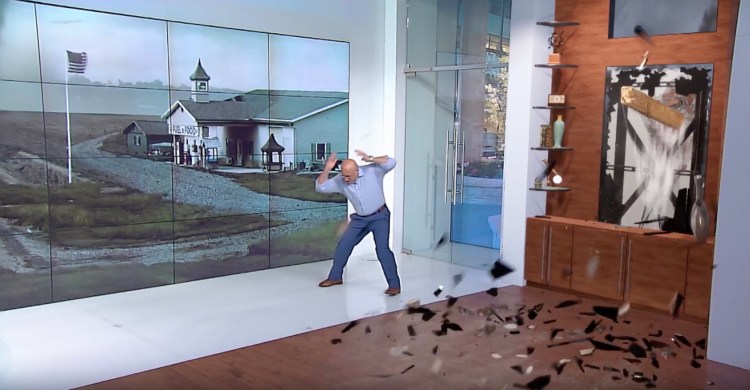With “fake news” on the rise and trust in journalism on the decline, this probably wasn’t the best time for the Weather Channel to demonstrate how “immersive mixed reality technology” will shape the vast majority of its upcoming broadcasts. But as an example of how CGI and augmented reality may shape the future of news, it’s certainly worth seeing.
Aired three times on the channel this morning, the “Tornado Hits The Weather Channel” video shows anchor Jim Cantore discussing a tornado strike from the apparent comfort of a studio, only to see the studio itself get hit by realistic lumber and vehicular debris. After a siren goes off, Cantore runs for cover, at which point the studio is torn apart, leaving him in a desolate field of rubble where only smoke and an American flag remain above ground level.
Ostensibly created to “educate and inform” viewers by placing them “inside of a storm environment,” the video is stunning both because it appears so close to real, and because it so easily walks over the line that historically separated news from entertainment. Cantore dodges, yells, and grimaces as debris appears to fly into the studio, but continues to explain how tornadoes create risks for nearby people and properties. Apart from blending real and seemingly-real CGI objects, the video uses traditional augmented reality-style pop-up graphics that float in the air while tracking with camera motions.
June 5th: The AI Audit in NYC
Join us next week in NYC to engage with top executive leaders, delving into strategies for auditing AI models to ensure fairness, optimal performance, and ethical compliance across diverse organizations. Secure your attendance for this exclusive invite-only event.
There’s a good reason the outdoor scenes look vaguely like a video game. Apart from Cantore, everything shown indoors and outdoors was generated by Epic Games’ Unreal Engine, which continues to advance in photorealism every year — and soon enough could eliminate the need for human anchors, as well. The video was created in partnership with The Future Group, which used its Unreal-powered Frontier to produce the real-time graphics and reached a long-term deal with the channel back in April.
In an announcement touting today’s broadcast, the Weather Channel says that the sequence will “ignite a revolution of weather presentation” as a new method of “real-time immersive storytelling.” The channel, which has been named “TV News Brand of the Year” for the past eight years by the Harris Poll, plans to use the technology in 80 percent of its programming by 2020.

